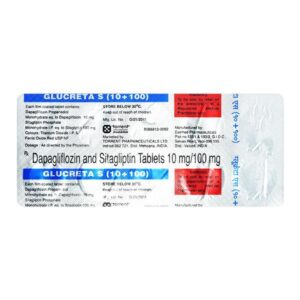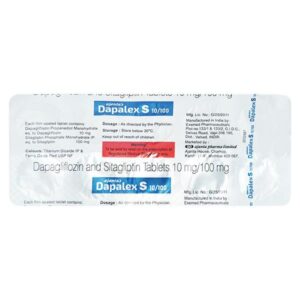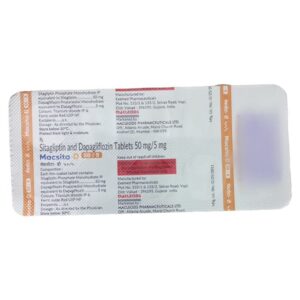SITAGLIPTIN PHOSPHATE + DAPAGLIFLOZIN
Sitagliptin Phosphate: Sitagliptin Phosphate is an oral antidiabetic medication used to control blood sugar levels in individuals with type 2 diabetes mellitus. It belongs to the class of drugs known as dipeptidyl peptidase-4 (DPP-4) inhibitors.
Mechanism of action: Sitagliptin works by inhibiting the enzyme DPP-4, which results in increased levels of a hormone called incretin. Incretin hormone helps to enhance the release of insulin and decrease the levels of glucagon, both of which help to regulate blood sugar levels.
Dosage: The usual recommended dose of Sitagliptin is 100 mg once daily. In patients with kidney problems or taking certain medications that may interact with Sitagliptin, the dose may need to be adjusted. It is important to follow the dosing instructions given by your healthcare provider.
Side effects: Some common side effects of Sitagliptin include headache, nausea, stomach pain, diarrhea, and upper respiratory tract infection. These side effects are usually mild and go away on their own. In rare cases, Sitagliptin may cause more serious side effects such as pancreatitis, allergic reactions, severe joint pain, or low blood sugar (hypoglycemia). It is important to seek medical attention if you experience any severe or persistent side effects.
It is important to note that Sitagliptin should be used in combination with a healthy diet and regular exercise to effectively manage blood sugar levels in individuals with type 2 diabetes. It is important to consult with a healthcare provider before starting or changing any medication regimen.
Dapagliflozin: Dapagliflozin is an oral medication that belongs to a class of drugs called sodium-glucose co-transporter 2 (SGLT2) inhibitors. It is primarily used to treat type 2 diabetes mellitus in adults.
The mechanism of action of dapagliflozin involves blocking the action of SGLT2 in the kidneys. SGLT2 is responsible for reabsorbing glucose from the filtered urine back into the bloodstream. By inhibiting SGLT2, dapagliflozin prevents glucose reabsorption, causing increased glucose excretion in urine, leading to lower blood glucose levels.
The usual recommended dose of dapagliflozin is 5 mg once daily, taken in the morning, with or without food. However, the dose can be increased to 10 mg once daily, depending on the patient’s individual response and tolerability. It is important to follow the instructions of a healthcare provider regarding the appropriate dose.
Common side effects of dapagliflozin may include urinary tract infections, genital yeast infections in both men and women, increased urination, thirst, dizziness, low blood pressure, mild genital itching or discomfort, and increased cholesterol levels. It is also important to be aware of the risk of dehydration, ketoacidosis (a serious condition characterized by high levels of ketones in the blood), and a rare but serious condition called necrotizing fasciitis of the perineum (an infection commonly known as Fournier’s gangrene).
It is essential to discuss any existing medical conditions or medications with a healthcare provider before starting dapagliflozin, to ensure it is safe and appropriate for individual use. Regular monitoring of blood glucose levels is necessary during treatment.



